Hong Gao
APVR: Hour-Level Long Video Understanding with Adaptive Pivot Visual Information Retrieval
Jun 05, 2025Abstract:Current video-based multimodal large language models struggle with hour-level video understanding due to computational constraints and inefficient information extraction from extensive temporal sequences. We propose APVR (Adaptive Pivot Visual information Retrieval), a training-free framework that addresses the memory wall limitation through hierarchical visual information retrieval. APVR operates via two complementary components: Pivot Frame Retrieval employs semantic expansion and multi-modal confidence scoring to identify semantically relevant video frames, while Pivot Token Retrieval performs query-aware attention-driven token selection within the pivot frames. This dual granularity approach enables processing of hour-long videos while maintaining semantic fidelity. Experimental validation on LongVideoBench and VideoMME demonstrates significant performance improvements, establishing state-of-the-art results for not only training-free but also training-based approaches while providing plug-and-play integration capability with existing MLLM architectures.
Examining the Role of LLM-Driven Interactions on Attention and Cognitive Engagement in Virtual Classrooms
May 12, 2025Abstract:Transforming educational technologies through the integration of large language models (LLMs) and virtual reality (VR) offers the potential for immersive and interactive learning experiences. However, the effects of LLMs on user engagement and attention in educational environments remain open questions. In this study, we utilized a fully LLM-driven virtual learning environment, where peers and teachers were LLM-driven, to examine how students behaved in such settings. Specifically, we investigate how peer question-asking behaviors influenced student engagement, attention, cognitive load, and learning outcomes and found that, in conditions where LLM-driven peer learners asked questions, students exhibited more targeted visual scanpaths, with their attention directed toward the learning content, particularly in complex subjects. Our results suggest that peer questions did not introduce extraneous cognitive load directly, as the cognitive load is strongly correlated with increased attention to the learning material. Considering these findings, we provide design recommendations for optimizing VR learning spaces.
NTIRE 2025 Challenge on Cross-Domain Few-Shot Object Detection: Methods and Results
Apr 14, 2025Abstract:Cross-Domain Few-Shot Object Detection (CD-FSOD) poses significant challenges to existing object detection and few-shot detection models when applied across domains. In conjunction with NTIRE 2025, we organized the 1st CD-FSOD Challenge, aiming to advance the performance of current object detectors on entirely novel target domains with only limited labeled data. The challenge attracted 152 registered participants, received submissions from 42 teams, and concluded with 13 teams making valid final submissions. Participants approached the task from diverse perspectives, proposing novel models that achieved new state-of-the-art (SOTA) results under both open-source and closed-source settings. In this report, we present an overview of the 1st NTIRE 2025 CD-FSOD Challenge, highlighting the proposed solutions and summarizing the results submitted by the participants.
Evaluating Usability and Engagement of Large Language Models in Virtual Reality for Traditional Scottish Curling
Aug 17, 2024



Abstract:This paper explores the innovative application of Large Language Models (LLMs) in Virtual Reality (VR) environments to promote heritage education, focusing on traditional Scottish curling presented in the game ``Scottish Bonspiel VR''. Our study compares the effectiveness of LLM-based chatbots with pre-defined scripted chatbots, evaluating key criteria such as usability, user engagement, and learning outcomes. The results show that LLM-based chatbots significantly improve interactivity and engagement, creating a more dynamic and immersive learning environment. This integration helps document and preserve cultural heritage and enhances dissemination processes, which are crucial for safeguarding intangible cultural heritage (ICH) amid environmental changes. Furthermore, the study highlights the potential of novel technologies in education to provide immersive experiences that foster a deeper appreciation of cultural heritage. These findings support the wider application of LLMs and VR in cultural education to address global challenges and promote sustainable practices to preserve and enhance cultural heritage.
Embedding Large Language Models into Extended Reality: Opportunities and Challenges for Inclusion, Engagement, and Privacy
Feb 06, 2024Abstract:Recent developments in computer graphics, hardware, artificial intelligence (AI), and human-computer interaction likely lead to extended reality (XR) devices and setups being more pervasive. While these devices and setups provide users with interactive, engaging, and immersive experiences with different sensing modalities, such as eye and hand trackers, many non-player characters are utilized in a pre-scripted way or by conventional AI techniques. In this paper, we argue for using large language models (LLMs) in XR by embedding them in virtual avatars or as narratives to facilitate more inclusive experiences through prompt engineering according to user profiles and fine-tuning the LLMs for particular purposes. We argue that such inclusion will facilitate diversity for XR use. In addition, we believe that with the versatile conversational capabilities of LLMs, users will engage more with XR environments, which might help XR be more used in everyday life. Lastly, we speculate that combining the information provided to LLM-powered environments by the users and the biometric data obtained through the sensors might lead to novel privacy invasions. While studying such possible privacy invasions, user privacy concerns and preferences should also be investigated. In summary, despite some challenges, embedding LLMs into XR is a promising and novel research area with several opportunities.
Eye-tracked Virtual Reality: A Comprehensive Survey on Methods and Privacy Challenges
May 23, 2023



Abstract:Latest developments in computer hardware, sensor technologies, and artificial intelligence can make virtual reality (VR) and virtual spaces an important part of human everyday life. Eye tracking offers not only a hands-free way of interaction but also the possibility of a deeper understanding of human visual attention and cognitive processes in VR. Despite these possibilities, eye-tracking data also reveal privacy-sensitive attributes of users when it is combined with the information about the presented stimulus. To address these possibilities and potential privacy issues, in this survey, we first cover major works in eye tracking, VR, and privacy areas between the years 2012 and 2022. While eye tracking in the VR part covers the complete pipeline of eye-tracking methodology from pupil detection and gaze estimation to offline use and analyses, as for privacy and security, we focus on eye-based authentication as well as computational methods to preserve the privacy of individuals and their eye-tracking data in VR. Later, taking all into consideration, we draw three main directions for the research community by mainly focusing on privacy challenges. In summary, this survey provides an extensive literature review of the utmost possibilities with eye tracking in VR and the privacy implications of those possibilities.
ExperienceThinking: Hyperparameter Optimization with Budget Constraints
Dec 02, 2019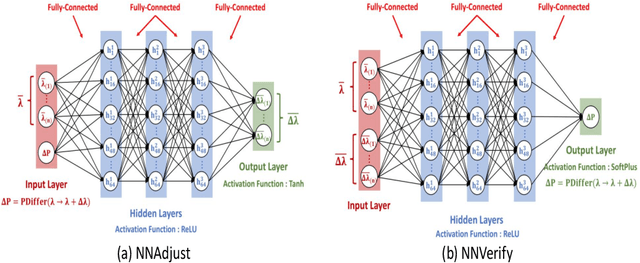
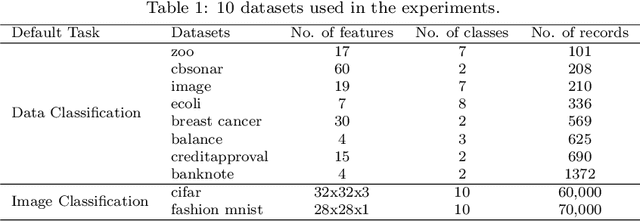
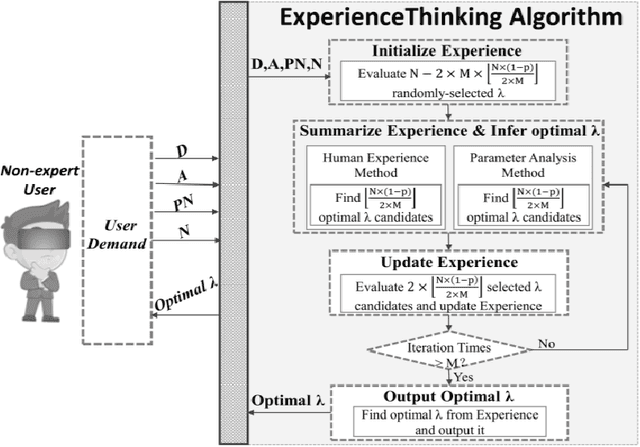
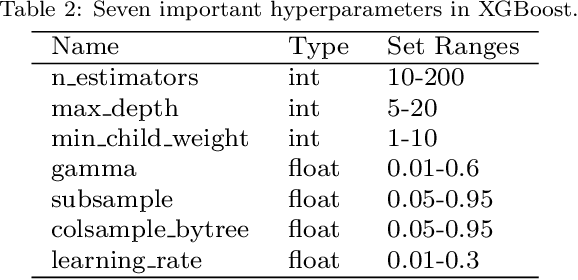
Abstract:The problem of hyperparameter optimization exists widely in the real life and many common tasks can be transformed into it, such as neural architecture search and feature subset selection. Without considering various constraints, the existing hyperparameter tuning techniques can solve these problems effectively by traversing as many hyperparameter configurations as possible. However, because of the limited resources and budget, it is not feasible to evaluate so many kinds of configurations, which requires us to design effective algorithms to find a best possible hyperparameter configuration with a finite number of configuration evaluations. In this paper, we simulate human thinking processes and combine the merit of the existing techniques, and thus propose a new algorithm called ExperienceThinking, trying to solve this constrained hyperparameter optimization problem. In addition, we analyze the performances of 3 classical hyperparameter optimization algorithms with a finite number of configuration evaluations, and compare with that of ExperienceThinking. The experimental results show that our proposed algorithm provides superior results and has better performance.
Auto-Model: Utilizing Research Papers and HPO Techniques to Deal with the CASH problem
Oct 24, 2019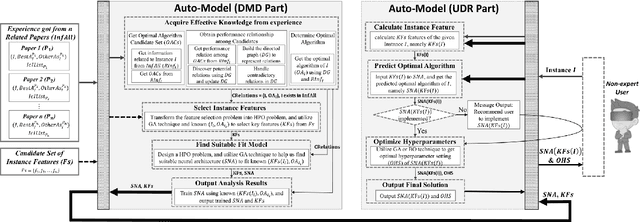



Abstract:In many fields, a mass of algorithms with completely different hyperparameters have been developed to address the same type of problems. Choosing the algorithm and hyperparameter setting correctly can promote the overall performance greatly, but users often fail to do so due to the absence of knowledge. How to help users to effectively and quickly select the suitable algorithm and hyperparameter settings for the given task instance is an important research topic nowadays, which is known as the CASH problem. In this paper, we design the Auto-Model approach, which makes full use of known information in the related research paper and introduces hyperparameter optimization techniques, to solve the CASH problem effectively. Auto-Model tremendously reduces the cost of algorithm implementations and hyperparameter configuration space, and thus capable of dealing with the CASH problem efficiently and easily. To demonstrate the benefit of Auto-Model, we compare it with classical Auto-Weka approach. The experimental results show that our proposed approach can provide superior results and achieves better performance in a short time.
Autoregressive-Model-Based Methods for Online Time Series Prediction with Missing Values: an Experimental Evaluation
Aug 27, 2019



Abstract:Time series prediction with missing values is an important problem of time series analysis since complete data is usually hard to obtain in many real-world applications. To model the generation of time series, autoregressive (AR) model is a basic and widely used one, which assumes that each observation in the time series is a noisy linear combination of some previous observations along with a constant shift. To tackle the problem of prediction with missing values, a number of methods were proposed based on various data models. For real application scenarios, how do these methods perform over different types of time series with different levels of data missing remains to be investigated. In this paper, we focus on online methods for AR-model-based time series prediction with missing values. We adapted five mainstream methods to fit in such a scenario. We make detailed discussion on each of them by introducing their core ideas about how to estimate the AR coefficients and their different strategies to deal with missing values. We also present algorithmic implementations for better understanding. In order to comprehensively evaluate these methods and do the comparison, we conduct experiments with various configurations of relative parameters over both synthetic and real data. From the experimental results, we derived several noteworthy conclusions and shows that imputation is a simple but reliable strategy to handle missing values in online prediction tasks.
Impacts of Dirty Data: and Experimental Evaluation
Mar 16, 2018
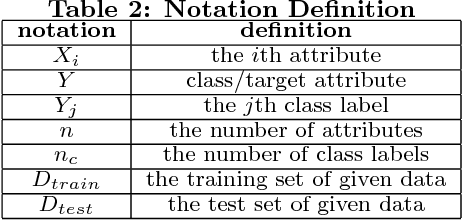
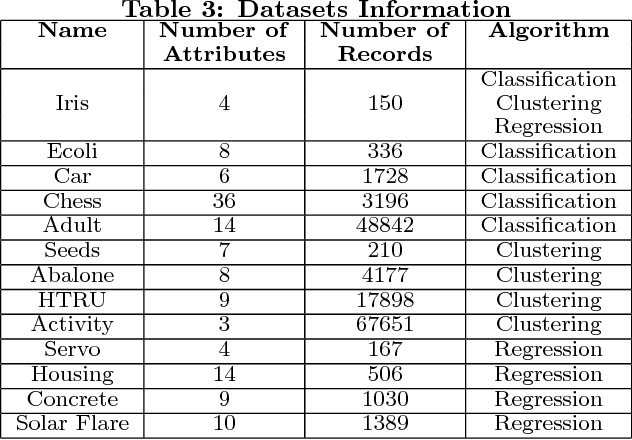
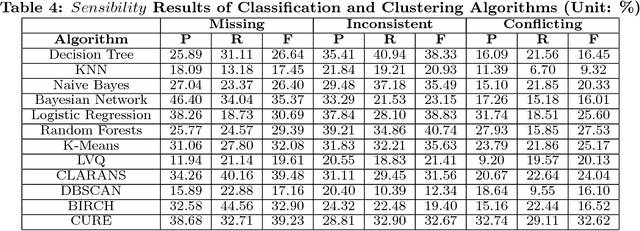
Abstract:Data quality issues have attracted widespread attention due to the negative impacts of dirty data on data mining and machine learning results. The relationship between data quality and the accuracy of results could be applied on the selection of the appropriate algorithm with the consideration of data quality and the determination of the data share to clean. However, rare research has focused on exploring such relationship. Motivated by this, this paper conducts an experimental comparison for the effects of missing, inconsistent and conflicting data on classification, clustering, and regression algorithms. Based on the experimental findings, we provide guidelines for algorithm selection and data cleaning.
 Add to Chrome
Add to Chrome Add to Firefox
Add to Firefox Add to Edge
Add to Edge